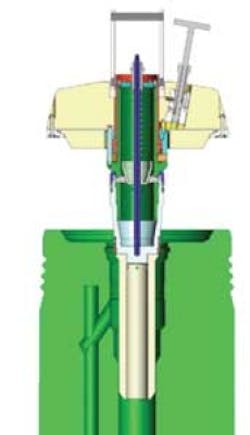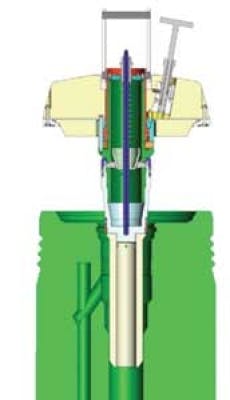Internal tree cap features ROV handling, metal seals
Fahad Malik - Aker Solutions
Engineers constantly strive to develop new technology and to find solutions to counter the obstacles set by large field developments, deepwater activities, high-pressure/high-temperature (HP/HT) reserves, long step-outs, and increased oil recovery demands. It is always challenging to design a product or system that fulfills the industry requirements while keeping in focus all the constraints.
For vertical subsea tree
The design is for an ROV installable/retrievable, pressure containing tree cap from Aker Solutions for use on a concentric bore “conventional” or “vertical” subsea tree. The tree cap is a barrier to keep the subsea environment clean in case of any leaks above the annulus or production swab valves. It includes a mechanism to indicate the metal seals have been set within the seal bore of subsea tree. The design also permits testing of the metal seals after installation. The vertical subsea tree typically has two bores, the annulus and the production bore, that are isolated by the insertion of a cap. It is rated for 10,000 ft (3,048 m) water depth, with a working pressure of 10,000 psi (69 MPa) and an operating system pressure of 3,000 psi (20.7 MPa).
The tree cap can be installed, tested, and recovered by an ROV. Upright orientation and submerged weight reduction is accomplished using syntactic foam. The ROV holds the cap by a foldable handle for transport; the handle folds to decrease the probability of snagging.
Prior tree caps generally require specific radial alignment to be inserted and secured in the tree. This accommodation to a particular radial alignment is difficult when installing a cap using an ROV. Aker’s tree cap is designed so an ROV can install it into a subsea tree at any rotational orientation.
Hydraulic pressure actuates the primary and secondary locking mechanisms to secure the cap into the subsea tree and to set the metal seals. It is important to prevent damage to the metal seals during installation. For this reason, the cap lands and locks into the subsea tree before setting the metal seals. It initially locks into the tree by a primary lock mechanism. Hydraulic pressure is applied into the cavity to move the piston downward, and the downward movement of the piston moves the upper set of locking dogs outward into the locking profile of the subsea tree to lock the cap selectively in the tree.
Setting and securing of metal seals is done by a secondary lock mechanism. A cam, rod, and spring method is adapted to set the secondary lock mechanism. Pressure continues to force the seal carrier to move downward which allows the cam and rod to move downward which permits the lower sets of dogs to engage, thus securing the seal carrier with both the metal seals into the designated position. Metal seals isolate the annulus and the production bores of the tree. The seal carrier includes one elastomeric seal adjacent to each of the metal seals.
Fluid can trap between the cavity of the tree cap and subsea tree, to prevent the cap from properly landing onto the tree. This is a problem for the light-weight tree cap. The design includes a flow path and a valve to permit removal of water trapped between tree and cap. The tree cap allows corrosion inhibitor to be injected into the cavity between tree and cap, and into the bores above the annulus and production valves. Tree cap vent pressure is contained in either bore through a vent line prior to its recovery. The upper and lower metal seals that isolate the annulus and production bores in the tree cap are tested and qualified to a working pressure of 15,000 psi (103 MPa) and temperatures from 0° F to 250° F (-17° C to 121° C).
Objectives
The following lists some of the objectives when designing the cap:
- Should not present a “snag hazard,” and should aid in damage control from dropped objects
- Is an environmental pressure barrier and is fitted, within and locked to, the subsea tree spool body
- Has a service water depth rating of 10,000 ft and a working pressure of 10,000 psig
- Is delivered ready for service to minimize rig activities and to reduce the possibility of safety incidents. It is manipulated subsea by the ROV
- When submerged, it has relatively neutral buoyancy, thus minimizing the tasks that the ROV has to perform in its installation, operation, and subsequent retrieval.
The following are the key design criteria that were considered in designing the cap:
- Weight in water must be less than 140 lbs (63.5 kg) negative
- Must be installed without any rotational orientation
- Allow for trapped volumes to be vented during installation
- Must be properly oriented and aligned prior to setting the seals
- Allow replacement of the trapped sea water beneath it by the injection of environmentally safe inhibitors to retard corrosion and marine growth
- Must provide a barrier between the adjacent annulus and production bores.

